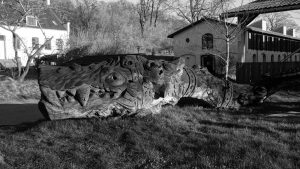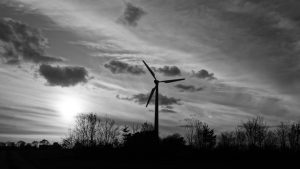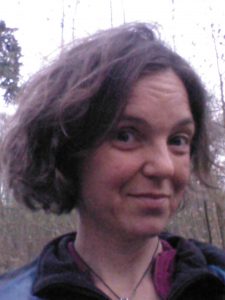Systems thinking

[2nd April 2017-2nd May 2017 Svanholm, Denmark]
The idea of community is as old as human beings themselves. It is by coming together in groups to protect, support and feed one another: in responsive systems that we survived through the ages. And in these groups we have created, explored, and evolved different ways of living together. The ancient communities were, the original, eco-communities: they were predominantly autonomous and self-sufficient. In more recent times, as a society we moved away from the ideas of creating community and instead towards individualisation. But this concept of being autonomous is a myth, no matter what way you look at it we need one another for shelter, clothing, food and support; there are few of us that are capable of absolute self-sufficiency: we are integral parts of this living earth system.
Within more recent history it is hard to say when the first modern eco-communities arose. Many eco-communities that now are members of the Global Eco-village Network, existed way before the word itself was coined. In the 1960’s several spiritually based projects were initiated in different parts of the world: Findhorn in Scotland, The Farm in the US, Sarvodaya in Sri Lanka, the NAAM movement in Burkina Faso, Auroville in India, and Solheimer in Iceland was formed in the 1930’s.
With a strong socialist history the Danes recognised the potential of eco-communities in the1960’s and started developing co-housing. Danish woman Hildur Jackson, a grass roots activist and advocate of the women’s movement, local community movements and organic farming, co-founded one of the early Danish co-housing projects in 1972 inspired by her passion to solve the dilemma that exists for women: working full-time and being isolated and dependent as housewives. She lived in a shared house with 6 families for 20 years and saw 12 children grow up there. In 1990 she co-founded the Global Ecovillage Network, which recognises and brings together eco-villages from all around the world. As yet, in Ireland there no co-housing projects and there is one Eco-village, in Cloughjordan. 
Hildur Jackson – co-creator of the Global Eco-village Network
Denmark is a relatively similar sized country to Ireland (Denmark 42,924 km2 Ireland 84,421 km2 ) with a similar population (Denmark 5.75M Ireland 4.6M)and climate, so I was curious to visit to find out about community life there. My ultimate destination was the Svanholm eco-community, which I wrote about, in a previous blog (Svanholm Selvforvaltning) but I started my journey in Copenhagen where I visited the famous Danish community of Christiania.
Christiania: Freetown, Copenhagen, Denmark.
Christiania is a 34 hectares (84 acres) site in the centre of Copenhagen. In the 1600’s it was a separate city in the more recent past it was a military barracks. In 1971 the site was occupied by a group, who declared it a freetown. Christiania’s mission statement says:
“The objective of Christiania is to create a self-governing society whereby each and every individual holds themselves responsible over the wellbeing of the entire community. Our society is to be economically self-sustaining and, as such, our aspiration is to be steadfast in our conviction that psychological and physical destitution can be averted.”
In contrast to its past military use the spirit of Christiania developed into one that embodied the hippie movement, the squatter movement, anarchism and collectivism. Today it is home to over 850 people, it has its own rules and is a living example of self-governing.
The site is not without controversy predominantly around the free sale of drugs on its infamous ‘Pusher Street’, which at one stage in 2011 led to the residents shutting the community down for a period of time. When I visited as part of my personal walking tour (thanks to my lovely friend Matthias) the sun was shining and the public areas were filled with locals and tourists. It definitely felt like a very different part of Copenhagen, to me it felt like the campus of an art college; with a huge mixture of people: some worse for ware due to excessive drug and alcohol consumption but predominantly there was a sense of curious creative edgy-ness to the place; I liked it! It reminded me of the passion I had as a student and of how Temple Bar was in Dublin when I first moved there in the early 90’s; when it was saved by ‘Group 91’ from being a large bus terminal and became a unique (although rather tourist overridden) hub of Dublin. Christiania most definitely defines a different way to live and is a living example of self governance and the Danish socialist spirit that has led them to be the developers of co-housing, eco-villages, and housing co-operatives.
A classic view of the old city of Copenhagen
As well as Christiania we explored more of Copenhagen; it was a joy and a surprise for me to feel so happy in the city after a month up in the Alps in Switzerland. I just loved being by the sea again and I was really struck by the peace and quiet and ease in so much of the city. This is due to how the city has been designed to maximise pedestrianisation and bicycle use and to reduce the use of cars. I know that in The Dublin City and many cities around the world are inspired by Copenhagen’s innovations; in the reduction of car use, their impressive public transport system and the widespread use of bicycles in particular.
The new Cycling and pedestrian bridge in Copenhagen
Cycling near Svanholm…no hands...
Copenhagen is set up for cycling in a way that puts most other cities to shame: from studies between 2008-2010 it has shown that within the city 150,000 people cycle each day to work or educational institutions in on the average journey in 36% travel by bicycle. 7% walk, 28% take public transport and 29% travel by car.
Cycling is a big part of day-to-day life in Denmark in general and from my experience in Copenhagen and in Svanholm and its environs I quickly got used to seeing adults and children on all sorts of bicycles from regular bikes, to unicycles, tandems and Cargo bikes. Cargo bikes are bicycles originated in Christiania in 1984, they are bicycles that have been adapted with large boxes to the front for carrying children groceries, whatever…and they are popular: 17% of Copenhagen families have one. I loved seeing entire families out together cycling just imagined how great it is for kids to grow up in such a healthy environment.
In Svanholm few people own cars and everyone cycles. There are cycle lanes along country roads and in the smallest towns. It shows how simply and easily cycling can be adapted when a country decides to embrace it. Cycle lanes are essential to create a safer environment and with them it encourages greater use and a lower dependence on cars. Many people say that they can’t live without their car; I agree that in the countryside travelling large distances a car is necessary but car pooling is a wonderful way to reduce the number of cars on the road. In the city it is so much easier: I have lived in Dublin without a car and instead with panniers for my bicycle. I never had a problem with groceries and loved the exercise. And for families its also very possible: my sister, her husband and their four children travel by bicycle, scooter or public transport; if they need a car they use the Go-Car, car pool scheme and for the odd long distance journeys they rent a car they need it. It’s far cheaper, far healthier for the family and infinitely better for the environment…and very do-able.

Cycle lanes in Kyndby near Svanholm, Denmark
There is so much about Denmark that is inspiring for me and of course I can’t talk about the country without talking about wind energy; being one of the world leaders in wind power uptake. Windmills can be seen from Copenhagen out at sea and they are dotted all around the country side of Denmark. One day sitting on a hill near Svanholm I counted 21 windmills quietly and majestically whirring away generating electricity for local communities and farms. Denmark has really embraced its capacity to harness wind energy and it plans to be 100 renewable for electricity by 2050 i.e. fossil free. Right now it produces 42% of its electricity from wind energy. (As a comparison Ireland is currently generates 24% according to the IWEA 2016) I love this source of renewable energy and find the dotted presence of windmills around the countryside in Denmark to be a beautiful indication Danish care for future generation. I have an early memory from the late 1970’s of attending a protest with my parents in Carnsore point in the South East of Ireland near where I grew up. There was a proposal to build a nuclear power plant and people were not happy. I am so grateful to the environmental groups that protested then as the plant was not built and on that site today there are 14 gorgeous wind turbines generating clean energy.
One of the two wind turbines at Svanholm.
In Svanholm and in the other eco-villages that I have visited I have really appreciated the more conscious and holistic way they look at the systems within which they live: at the interconnection between people, building, energy, water, environment, food and waste. I am fascinated and curious about the connections that occur between living and manmade aspects of systems and I am especially interested in how materials are used and re-used and it is in the area of waste that I have been quite challenged in communities in relation to how existing municipal infrastructure dictates waste management choices. In nature nothing is wasted organic material becomes food /compost for seeds and seedling to become mature plants and then they become food. It’s the natural order of a sustainable system.
In Svanholm I worked in the building group and have seen the very impressive sorting system they have for material waste that comes from building, maintenance etc: wooden furniture and metal furniture, electronics non, hard plastics, glass, ceramics etc. It is all sorted brought to the local waste sorting plant. I went along to the local plant Skibby to see and was really impressed with the impressive array of separate materials that are gathered their. I don’t however know how much of this is recycled, reused or incinerated.
Local waste collection plant in Skibby near Svanholm, Denmark
Other sources of waste as Svanholm come from the kitchens: Organic waste is all either composted on site, fed to pigs or collected by the local council for community composting. The reminder of household waste including cardboard, paper, plastics from food wrappings etc are all incinerated. Incineration is how most household waste is treated in this particular municipality (or commune) of Denmark. Materials are not recycled but burned and this is not a solution that sits comfortably with me.
I’ve talked with folks at Svanholm who have researched the issue in detail and they reassure me that the scrubbers used on the exhaust from the incineration plant along with the high temperatures used ensure that all toxins are burned off. I remain unconvinced that there is no pollution and need to do more research myself in this area. The pollution is one aspect of the problem with incineration as I see it, and the other is with the plastic habit that incineration perpetuates. Incineration is a short term solution for a much greater issue of a linear waste management system that is not sustainable. It reinforces the habit of producing waste rather than promoting the reduction of it. You may gain calorific value from incinerating plastic but this does not negate the amount of energy used to refine and process the petroleum in the first place to generate the plastic. Once the material is burned and the heat gathered, its potential is gone as we cannot reproduce petroleum-based plastics. We cannot re-create petroleum in its fossil based form. To burn these highly complex materials really is not a solution in my opinion but a distraction from better solutions. Incineration helps reduce waste going to landfill but does not promote the reduction in waste production.
Svanholm as a community is independent energy wise and has its own water supply, it provides most of its food it and manages its own waste water on site but in the area of material recycling is not a simple matter of recycling on site: it is dependent on the local council’s waste and recycling plan. This issue is obviously greater than what can be decide on within a community and therefore eco-village participation in local and regional politics is essential.
 Dragon sculpture at Svanholm, Denmark.
Dragon sculpture at Svanholm, Denmark.
For me I’m interested in how we can live in balance within living systems and an important part of that for me is in my relationship to spirit and my own spiritual practices. To be honest, it is the most important thing in my life: to really learn to be authentic and to offer all that is mine to offer in the world. In my previous Svanholm blog (Svanholm Selvforvaltning) I wrote about how I was not sure about teaching Movement Medicine. I judged that the community might not be open to it. After my last blog I started to wonder about my journey and how I could honour my promise to offer my creativity in community and so with some support I did finally offer a class and to my delight, it was really well received. I am learning what it is to offer what I have in community, to take risks to find how my offerings fit into different community systems and I’m learning to trust in the capacities of these communities to accept people for who they are; allowing them to express themselves freely in a supported environment. Its a wonderful way to rear children and its a wonderful way to treat fellow community members.

Picture of some of the early Svanholm community
As with other communities it is the people who really make the place and I have so enjoyed laughing, story telling and discussing Danish politics with Sofie, Thor, Zach, Clara and Naia and have enjoyed the companionship of the Building group for interesting conversations about recycling policies in Denmark a field trip to the local recycling centre, sharing Irish coffees and laughs with Mogens, Jes, Jesper, Volker, Bo, Tom and Toke. And I have enjoyed the parents and children the young and the old and all the smiling Danish, faces that I have grown to appreciate so much. I really loved my time in Svanholm and feel so inspired by the structure, order, communication, ease and flow of this intelligent responsive wonderful living community system.
My project of exploring community is fully supported by my creativity through the sale of my art and by community through crowd funding. If you would like to support me on this journey you can check out my art on www.sineadcullen.com or make a donation on my Crowd funding https://www.gofundme.com/LetsCreate
References and links for subjects included in this blog
- Copenhagen: http://www.copenhagenize.com/
- Cloughjordan Eco-village Ireland http://www.thevillage.ie/about-us/the-project/
- Wind energy in Ireland https://en.wikipedia.org/wiki/Wind_power_in_the_Republic_of_Ireland#cite_note-4
- Wind energy Irish Wind energy association www.iwea.com
- Carnsore point https://en.wikipedia.org/wiki/Carnsore_Point
- Hildur Jackson http://gaia.org/gaia-trust/hildur-jackson/
- Cycling Strategy Copenhagen http://www.eltis.org/sites/eltis/files/case-studies/documents/copenhagens_cycling_strategy.pdf
- McDonough & Braungart – (2002). Cradle to cradle: Remaking the Way We Make Things. New York: North Point Press







Recent Comments